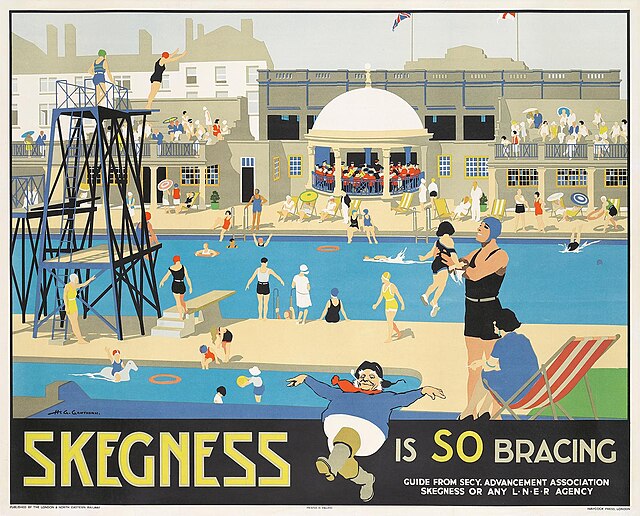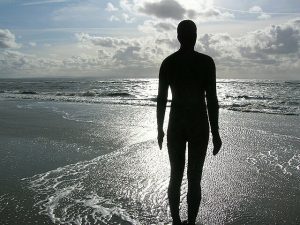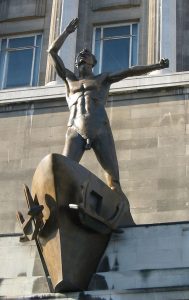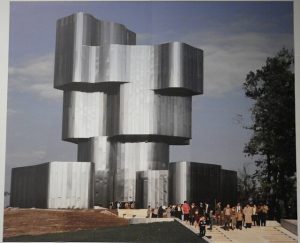
Art Appreciation – August/September 2025
As we reviewed the range of topics explored in the Art App Group over the years, we realised that we have not given much attention to sculpture. So, in August, we decided to invite members to choose a piece of ‘Public Art’ and talk about it for a few minutes. This is a very broad term and, as ever, members interpreted it in varied ways.

We started by looking at one of Britain’s best loved contemporary sculptors, Anthony Gormley, and his work ‘Another Place’ on the beach at Crosby. This extraordinary work shows a number of isolated figures scattered across an expanse of tidal seashore, all facing out to sea. What a feat of design and engineering to ensure that these figures remain secure in the ever shifting sands of the seashore! It was intriguing to see how nature is taking over, as barnacles are making the figures their home.
Another work by Anthony Gormley, ‘The Iron Man’, was part of a group of sculptures which adorn the public spaces of Birmingham. These include ‘Boulton, Watt and Murdoch’ celebrating some of the city’s great industrialists, ‘The Forward Statue’ showing a range of other significant local figures, ‘The Floozie in the Jacuzzi’, and a portrayal of the comedian and local lad, Tony Hancock. Some of these have proven problematic in terms of maintenance and cost to the council but they are mostly much enjoyed by the community.

One of the most notable sculptors of the last century was Jacob Epstein. His statue ‘Liverpool Resurgent’ was made in 1956 to adorn the entrance to what was Lewis’s department store, rebuilt after war time bomb damage. It remains an important landmark in the city, even being mentioned in the famous song.
In my Liverpool Home, In my Liverpool Home
We speak with an accent exceedingly rare,
Meet under a statue exceedingly bare,
And if you want a Cathedral, we’ve got one to spare
In my Liverpool Home.
Two of the most remarkable works of art we looked at were previously unknown to most – or all – of us. ‘The Apennine Colossus’ in Tuscany is a massive sculpture created out of a mountain side in the 1580s. Apart from its towering and brooding presence, it was originally made to include visual effects such as a light show and fireworks. Closer to home in the Forest of Dean, as part of a sculpture trail, ‘Cathedral’ is a stunning stained glass design showing images of the local landscape. Made in 1986, it is suspended between rows of large trees which resemble columns in the nave of a medieval cathedral.

Public art is often about propaganda to give messages to the public. One of the best examples of this are the ‘spomeniks’ built by Tito’s regime in Yugoslavia in the period 1945-90. There are about 4000 of these imposing sculptures, mainly avant garde in style, and built to mark either the achievements of the Partizans in fighting fascism, or commemorating atrocities committed by fascist forces. Some of these frequently massive structures have been abandoned and vandalised but many survive in the states of the former Yugoslavia.
Public art of a very different kind are the ever popular posters promoting rail travel in the mid-20th century. These posters with their distinctive, bold and colourful designs offer a nostalgic view of Britain, celebrating tourist attractions as well as the glamour and drama of travel by steam. They are currently enjoying a resurgence in popularity.
For almost two centuries the ‘fourth plinth’ in Trafalgar Square was empty, but from 1999 it has been the site of some remarkable works of art which change every year. We looked at a number of these sculptures and heard something of the stories behind them. There are too many to list here but one of the most remarkable was ‘Alison Lapper Pregnant’ by Marc Quinn. Alison Lapper is an artist and a victim of thalidomide. This sculpture makes us reconsider our view of disability and what constitutes beauty and art. We had a closer look at ‘The Invisible Enemy Should Not Exist’ by Michael Rakowitz which recreated a sculpture in Iraq which was destroyed by ISIS in 2015. It has been made from empty Iraqi date syrup cans, representing the destruction of the country’s date industry.
One of the most memorable images is ‘The Kelpies’, the heads of two massive horses which stand between Falkirk and Grangemouth near the M9 in Scotland. The name recalls the shape shifting horses of Scottish legend but also represent the lineage of the heavy horses of Scottish industry and economy, pulling the wagons, ploughs, barges, and coal ships that shaped the geographical layout of the Falkirk area.
Finally, we looked at some of the works of art which formed part of the Gratitude Trail which toured Manchester, Birmingham and other cities. These 51 highly decorated and colourful figures were designed to show appreciation for the key workers who did so much for us all during the pandemic.
Our next meeting will be a week later than our customary second Tuesday of the month, on 16th September. We have asked members to choose a work of art on the theme of ‘Other Cultures’.
Lynne Vick
